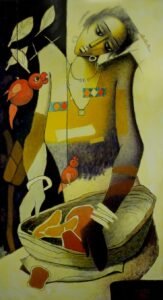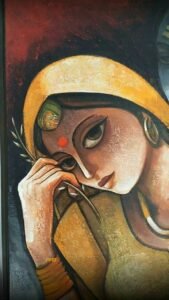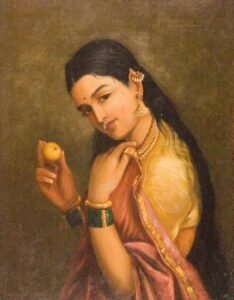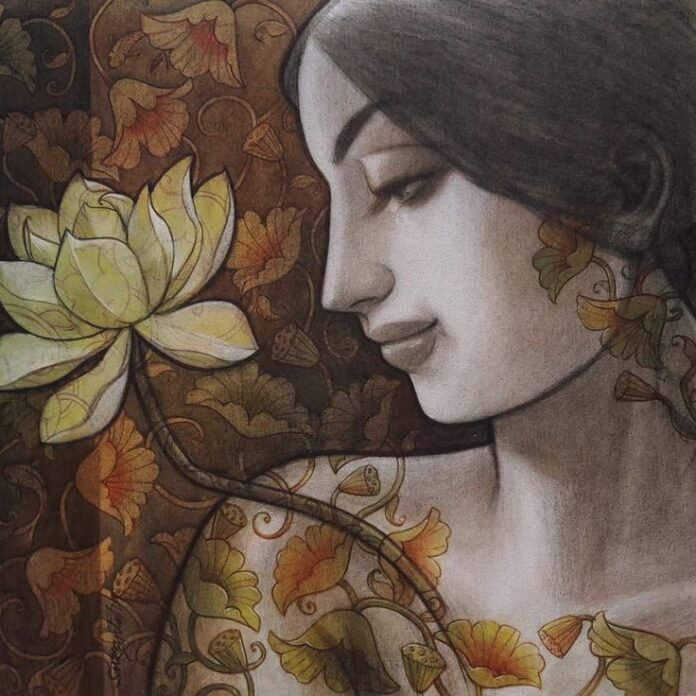Indian Paintings are essential for every collection, regardless matter whether you are an art fan or simply find Indian culture to be beautiful.
As well as honoring India’s glorious heritage, these designs bring a touch of elegance to every space they grace.
Having a wide range of traditions, cultures, and tongues, India has captivated the globe for centuries with its dazzling and vibrant artwork, which is a reflection of its long history. The deeply embedded history, traditions, and beliefs of India are depicted in the country’s art; they are woven into intricate patterns and motifs that have a lasting impact on anyone who sees them.

Indian art has been admired for its vivid colors and complex designs for centuries. India is a diverse country, and its artistic representations reflect this diversity, with each region having its distinct style and approach. Indian paintings feature a variety of styles, each with its unique beauty. The Madhubani paintings of Bihar, the Warli paintings of Maharashtra, the Tanjore paintings of Tamil Nadu, and the Pattachitra paintings of Odisha.
Explore the magical world of Indian Art Prints and discover the splendor of Indian art for yourself.
Delving into the Essence of Indian Paintings

An integral facet of Indian artistry, Indian Art Prints are distinguished by their intricate patterns and vibrant hues. With roots deeply embedded in India, these prints have evolved over centuries, employing diverse printing techniques such as digital printing, lithography, etching, and woodblock printing.
Originating in the 16th century under the Mughal Empire, Indian Art Prints gained prominence during a flourishing artistic era, particularly in the realm of miniature paintings. The 19th and 20th centuries witnessed a surge in popularity, facilitated by the British introduction of printing technology to India. Since then, Indian artists have embarked on a journey of exploration, experimenting with designs, techniques, and materials, creating prints that encapsulate the nation’s cultural tapestry.

Indian art is broadly classified into three categories: traditional, modern, and contemporary. Traditional Indian Art Prints draw inspiration from historic artistic traditions such as Warli, Kalamkari, and Madhubani, featuring intricate patterns and motifs passed down through generations.
The 20th century marked a period of experimentation, giving rise to modern Indian art prints that fuse Western influences with vivid colors and abstract patterns. Contemporary Indian art prints seamlessly blend traditional and modern styles, incorporating experimental techniques and materials while addressing current social, political, and cultural themes.
The creation of Indian art prints involves various printing methods, including woodblock printing, lithography, etching, and digital printing. Woodblock printing entails carving a wooden block with the design, applying ink, and pressing it onto paper. Lithography involves transferring a design onto a stone or metal plate before printing. Etching employs acid to create a design on a metal plate, which is then inked and printed. Digital printing utilizes computer-generated designs printed onto paper by a digital printer.
Indian art paintings, with their diverse forms and techniques, serve as a beautiful and intricate reflection of the nation’s rich cultural heritage. The captivating world of Indian art prints caters to a wide range of preferences, whether one leans towards classic, modern, or contemporary expressions of artistic brilliance.

Embarking on the journey of buying Indian paintings is a captivating exploration of the nation’s rich artistic heritage. With a history deeply rooted in cultural traditions, Indian paintings offer a diverse tapestry of styles, themes, and techniques. Before making a purchase, it is crucial to delve into the vast array of Indian art, and understand the distinctions between traditional, modern, and contemporary genres. Researching various artists, their reputations, and the significance of their works can guide toward collectors towards informed choices.
Trusted sources such as renowned galleries, museums, and reputable online platforms play a vital role in securing authentic pieces, ensuring both the investment’s value and the appreciation of the artistry involved. Whether drawn to the intricate details of traditional pieces or captivated by the vibrancy of contemporary expressions, buying Indian paintings opens a door to a world where each stroke tells a story and every canvas reflects the soul of a rich cultural legacy.
The significance of Indian art prints
Indian arts impressions, which have been passed down through the years, are a reflection of the country’s rich artistic heritage and varied cultural past. This includes mythology, folklore, and religion.
An important incident or tale from Indian history has been depicted in Indian art prints. Raja Ravi Varma, for example, depicted scenes from the Ramayana, the Hindu epic, and the life of Krishna in his artwork. Mughal miniatures of the 16th and 17th centuries show the lives of the emperors, their courtiers, and other significant personalities of the time.

Art prints from India have also significantly influenced contemporary design and art. Many contemporary and modern Indian artists draw inspiration from the rich artistic traditions of India, using elements of Indian art prints in their works. To create her distinctive pieces, Rina Banerjee combines modern materials like plastic and steel with traditional Indian techniques such as tiny paintings and needlework.
A major role of Indian paintings are to preserve the mythology, folklore, and religious traditions of the nation. They continue to inspire modern artists and designers in a wide range of fields.
Indian artists have created some magnificent works of art that have taken the world by storm. In no particular order, here is a list of 12 of the most famous Indian paintings of all time – recognizable pieces from the ages that will never be forgotten.
Navigating the World of Collecting Indian Art Prints
For those considering the acquisition of Indian art prints, here are some valuable recommendations to guide your selection and purchase:
Conduct Thorough Research:
Before making a purchase, delve into the diverse realm of Indian art prints. Familiarize yourself with various print types, styles, and techniques to make an informed decision and ensure the authenticity of your chosen artwork.
Trustworthy Retailers:
Opt for reputable sources like well-established online marketplaces, galleries, and museums when purchasing Indian art prints. Choosing trusted retailers safeguards your investment and ensures the acquisition of genuine pieces.
Consider Artist Reputation:
Take into account the reputation of the artist when selecting Indian art prints. Look for creators with a substantial following and a recognized body of work to enhance the value and authenticity of your chosen print.
Prioritize Quality over Quantity:
Instead of acquiring numerous low-quality prints, invest in a single high-quality piece that will stand the test of time. Opt for prints crafted with superior tools and materials, ensuring longevity and aesthetic appeal.
Taking Care of Indian Paintings:
Gentle Handling:
Handle Indian art paintings with care, avoiding direct contact with the print’s surface to minimize the risk of damage or smudging.
Optimal Display Conditions:
Display Indian art prints in well-lit rooms with moderate temperature and humidity levels to prevent deterioration over time.
Caution in Cleaning:
When cleaning is necessary, use a soft brush or cloth to remove dust or grime, avoiding water or cleaning agents that may harm the print.
Noteworthy Indian Painters and Their Works:

Raja Ravi Varma:
Renowned for depicting Indian mythology and history with intricate details and vibrant colors, Raja Ravi Varma’s art captivates with its emotional depth.
Tyeb Mehta:
As a modern artist, Tyeb Mehta’s geometric and minimalist prints reflect a powerful commentary on human emotions and societal experiences.
M.F. Husain:
Celebrated for vivid, abstract paintings, M.F. Husain’s work captures the grace and beauty of horses, contributing significantly to modern Indian art.
Rabindranath Tagore:
A polymathic figure, Tagore’s self-portrait and other paintings showcase his diverse talents, offering a glimpse into India’s cultural richness.
Jamini Roy:
A pioneer in integrating folk and tribal art into mainstream Indian Painting, Jamini Roy’s contributions have left an enduring impact on the art landscape.
Embarking on the Journey of Collection:
By assembling a collection of Indian art prints, one can connect deeply with India’s cultural heritage and aesthetic traditions. The careful selection, purchase, and maintenance of these prints contribute to the creation of a priceless and visually stunning collection.

The world of Indian Painting offers a broad spectrum of themes, styles, and techniques, providing a unique insight into India’s rich cultural past. Whether you are a seasoned collector or a newcomer, the diverse offerings—from intricate traditional prints to vibrant contemporary styles—promise an engaging and enriching experience.
Consider adding a few Indian artwork to your collection and explore the beauty and cultural wealth of India’s artistic legacy. Learning about the significance and beauty of these prints can enhance your appreciation, helping you discover new favorites and artists that resonate with you in unexpected ways. Immerse yourself in the world of Indian artwork to uncover the beauty and richness of India’s cultural tapestry.


